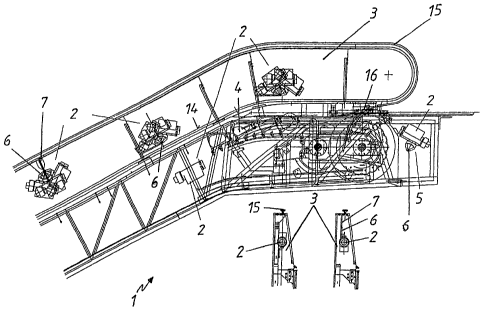Some of the information on this Web page has been provided by external sources. The Government of Canada is not responsible for the accuracy, reliability or currency of the information supplied by external sources. Users wishing to rely upon this information should consult directly with the source of the information. Content provided by external sources is not subject to official languages, privacy and accessibility requirements.
Any discrepancies in the text and image of the Claims and Abstract are due to differing posting times. Text of the Claims and Abstract are posted:
| (12) Patent: | (11) CA 2473473 |
|---|---|
| (54) English Title: | DEVICE FOR HEATING ESCALATORS OR MOVING SIDEWALKS |
| (54) French Title: | DISPOSITIF POUR CHAUFFER DES ESCALIERS ROULANTS OU DES TROTTOIRS ROULANTS |
| Status: | Deemed expired |
| (51) International Patent Classification (IPC): |
|
|---|---|
| (72) Inventors : |
|
| (73) Owners : |
|
| (71) Applicants : |
|
| (74) Agent: | ROBIC |
| (74) Associate agent: | |
| (45) Issued: | 2010-11-09 |
| (86) PCT Filing Date: | 2003-01-10 |
| (87) Open to Public Inspection: | 2003-08-14 |
| Examination requested: | 2007-12-11 |
| Availability of licence: | N/A |
| (25) Language of filing: | English |
| Patent Cooperation Treaty (PCT): | Yes |
|---|---|
| (86) PCT Filing Number: | PCT/EP2003/000168 |
| (87) International Publication Number: | WO2003/066502 |
| (85) National Entry: | 2004-07-14 |
| (30) Application Priority Data: | ||||||
|---|---|---|---|---|---|---|
|
The invention relates to a device for heating especially the mobile components
of an escalator or a moving sidewalk, comprising at least one heating element.
The hot air emerging from said heating element is directed onto the respective
component in a substantially precise manner.
L'invention concerne un dispositif de chauffage destiné à chauffer en particulier les composants mobiles d'un escalier roulant ou d'un trottoir roulant, comprenant au moins un élément chauffant dont la sortie d'air chaud est dirigée de manière sensiblement précise vers le composant correspondant.
Note: Claims are shown in the official language in which they were submitted.
Note: Descriptions are shown in the official language in which they were submitted.

For a clearer understanding of the status of the application/patent presented on this page, the site Disclaimer , as well as the definitions for Patent , Administrative Status , Maintenance Fee and Payment History should be consulted.
| Title | Date |
|---|---|
| Forecasted Issue Date | 2010-11-09 |
| (86) PCT Filing Date | 2003-01-10 |
| (87) PCT Publication Date | 2003-08-14 |
| (85) National Entry | 2004-07-14 |
| Examination Requested | 2007-12-11 |
| (45) Issued | 2010-11-09 |
| Deemed Expired | 2018-01-10 |
There is no abandonment history.
| Fee Type | Anniversary Year | Due Date | Amount Paid | Paid Date |
|---|---|---|---|---|
| Application Fee | $400.00 | 2004-07-14 | ||
| Maintenance Fee - Application - New Act | 2 | 2005-01-10 | $100.00 | 2004-10-29 |
| Registration of a document - section 124 | $100.00 | 2005-06-23 | ||
| Maintenance Fee - Application - New Act | 3 | 2006-01-10 | $100.00 | 2005-11-29 |
| Maintenance Fee - Application - New Act | 4 | 2007-01-10 | $100.00 | 2006-10-18 |
| Maintenance Fee - Application - New Act | 5 | 2008-01-10 | $200.00 | 2007-11-22 |
| Request for Examination | $800.00 | 2007-12-11 | ||
| Maintenance Fee - Application - New Act | 6 | 2009-01-12 | $200.00 | 2008-10-27 |
| Maintenance Fee - Application - New Act | 7 | 2010-01-11 | $200.00 | 2009-10-29 |
| Final Fee | $300.00 | 2010-08-19 | ||
| Maintenance Fee - Patent - New Act | 8 | 2011-01-10 | $200.00 | 2010-11-05 |
| Maintenance Fee - Patent - New Act | 9 | 2012-01-10 | $200.00 | 2011-12-29 |
| Maintenance Fee - Patent - New Act | 10 | 2013-01-10 | $250.00 | 2012-12-20 |
| Maintenance Fee - Patent - New Act | 11 | 2014-01-10 | $250.00 | 2013-12-20 |
| Maintenance Fee - Patent - New Act | 12 | 2015-01-12 | $250.00 | 2014-12-22 |
| Maintenance Fee - Patent - New Act | 13 | 2016-01-11 | $250.00 | 2015-12-28 |
Note: Records showing the ownership history in alphabetical order.
| Current Owners on Record |
|---|
| KONE CORPORATION |
| Past Owners on Record |
|---|
| BUESCHER, HANS-WERNER |
| KLEINE-BRUEGGENEY, HANS |